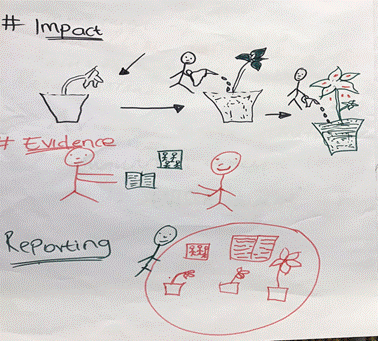Overview:
- Welcome, introductions, intentions and programme, social contract
Intentions:
- Familiarise participants with the intentions, ways of working and the envisioned process for the 3 days, get to know one another, agree to ways of working/social contract and commit to quality attention and joint care for process
- Anchoring the process
- Finding and holding the energy
- Official welcome by Mampe on behalf of NMCF
Since SeViSSA started, this is first Learning and Reflection event. Key areas that need to be addressed are the reporting elements and demonstrating evidence of impact of the amazing work being done.
- Facilitators introduce themselves. Overview of methods and facilitation as container:
- Seamless co-creation/co-facilitation
- Various streams of conversations
- Free writing/journaling
- Peer reflection/peer coaching
- Experiential exercises and joint reflections
- Right brain/creative exercises
- Check in and check out daily
- Introductions (each person introduce themselves and their organization, province) and check-in
Participants checked in in with the overall feeling that is in their body, mind or spirit at that moment.
- Intention and process
Participants were asked to write themselves a welcome note to the workshop, comprising 3 sentences. They were also asked to set their own intentions for the workshop, thus at the end of the 3 days, if this workshop has been a success and worth my time x, y and z should have happened for me.
Overview of the intentions shared by participants…
- To learn new ideas, skills, and tools from others and share stories and experiences;
- To participate fully, be energetic, cooperative, have fun and a positive attitude;
- Learn what others are doing and be inspired;
- To engage, ask questions, give feedback, listen and reflect;
- To assess if on right track, identify ways to improve or grow the work and fill gaps;
- To see how to take back and implement new knowledge;
- To process, unpack and learn lessons from the work;
- To improve on report-writing (tell the stories of impact);
- To be able to single out a SeViSSA child from the rest;
- To explore different issues and context of different coalitions and also best practices;
- To explore good communication with each other and share different strategies;
- To feel confident in the work that is being done;
- To learn about self-care strategies (emotional wellbeing) from others;
- Identify a way forward beyond SeViSSA;
- To celebrate all the work and acknowledge the knowledge and experiences;
- To treat each other with respect;
- Improve ways of working and enable achieving of results;
- To move from activity to impact in reporting (change made is missing);
- The following Social contract (agreement on ways of working) was agreed with the participants;
- Trust allowance, emergent process
- One meeting, one forum (speak through the facilitator)
- Take responsibility for co-creation
- Principle of 50:50 – give and take
- Take responsibility or personal care and comfort
- Embrace diversity – different ways of looking and see
- Time management – use time efficiently
- Being respectful
- Ease up and have fun and colour in process
- Phone on silent/vibration (answer responsibly and respectfully)
Each day participants volunteered for roles as process facilitators, time keepers and energizers. Sharing of these roles between the lead facilitators and participants helped (i) to maintain a tight energy container for the workshop, and (ii) to underscore the joint responsibility for a successful event.

